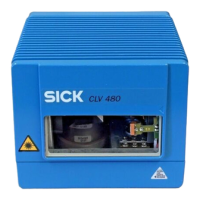Operating Instructions Chapter 3
CLV 480 Bar Code Scanner
8 010 080/O824/10-02-2005 © SICK AG · Division Auto Ident · Germany · All rights reserved 3-9
Product description
In addition to parking (fixed position) and simple deflection with maximum amplitude, opti-
mized oscillating mirror functions are also available:
• Oscillating with variable deflection amplitude per distance configuration
• One-Shot: one-off, defined deflection per reading pulse (forward and return phase)
3.2.4 Additional components
Heater
The CLV can be permanently equipped with a heater for applications involving temperatures
up to max. –35 °C (–31 °F), e. g. in a freezer.
The design, technical data, and power-up behavior of the CLV are described in Chapter 10.4
Optional heating, Page 10-26.
External parameter memory
The external parameter memory is located in a connector cover which, when mounted,
covers the two electrical terminals on the CLV (IP 65). The parameter memory saves you
time when a CLV is replaced locally by providing a copy of the current parameter set. In other
words, you do not have to configure the new device.
For information on applications and operating procedures, see Chapter 10.3 Installing and
operating the external parameter memory, Page 10-22.
3.3 Indicators and control elements
3.3.1 Control elements
The CLV is operated and configured via the terminal interface (auxiliary interface) using the
"CLV-Setup" program or using command strings sent via the host interface/terminal inter
-
face. A variety of parameter options allow you to adapt the device to a wide range of appli-
cations.
The following can be defined:
• The configuration of the code types
• The read, evaluation, and output properties
• The communication parameters of the host interface/CAN interface
• The structure of the data output string for "Good Read" and "No Read" on the host in-
terface/CAN interface
• The function of the terminal interface
Chapter 10.6 Installing and operating the "CLV-Setup" program, Page 10-29 describes the
procedure for installing the "CLV-Setup" program and explains how to use it. The parame-
terization (configuration) procedure is explained in Chapter 6.4 Configuring (parameterizati-
on) the CLV, Page 6-5.
3.3.2 Function of the LEDs
Four LEDs indicate the operating status, activity of the laser diode, reading result status, and
data transfer on the host interface. The LEDs are located on the rear of the device (
Fig. 3-5,
Page 3-10).
If the optional external parameter memory is connected, the LEDs also indicate whether the
memory was successfully accessed.

